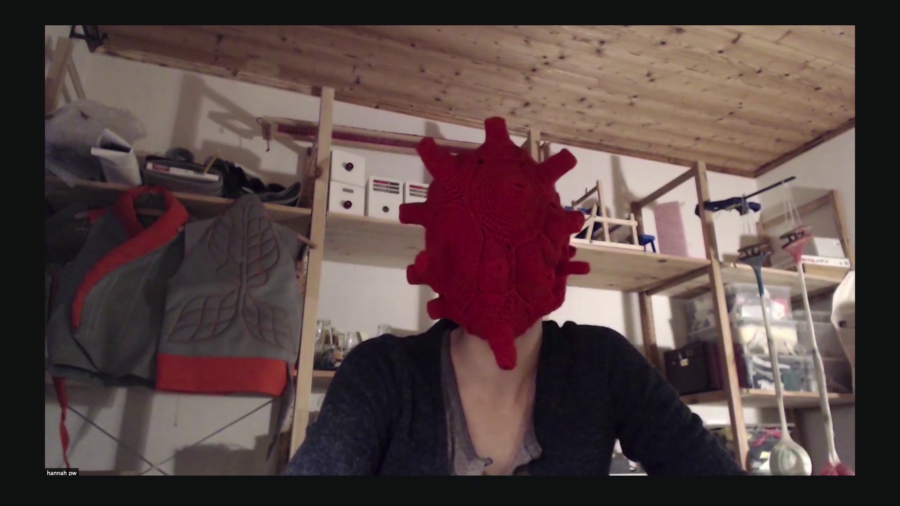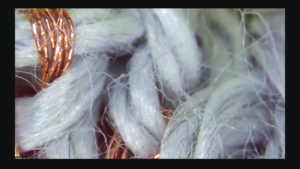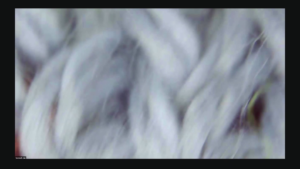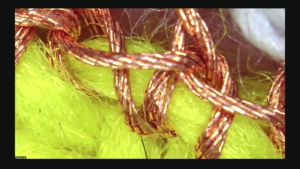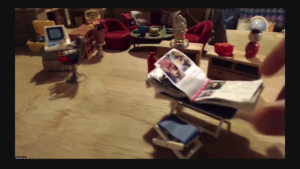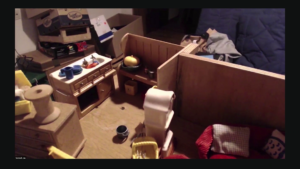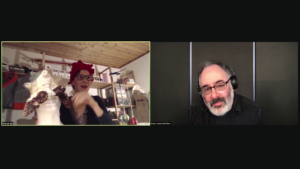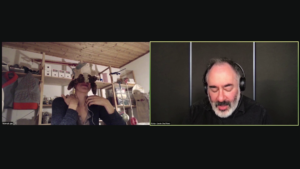Golan Levin: Good morning, everyone, and welcome back for our third presentation of Friday morning of Art && Code: Homemade. It’s our terrific pleasure to introduce hannah perner-wilson, who develops new types of artifacts that emphasize materiality and process, and which allow us to glimpse another world of electronic diversity. perner-wilson is Professor of Digital Games & Objects at the Ernst Busch Academy of Dramatic Arts in Berlin. hannah perner-wilson.
hannah perner-wilson: Thank you, Golan. Yeah, hello everyone who I can’t can’t see. I’m actually calling from a small town in the Austrian Alps, and my Internet connection’s not that great, so I’m hoping that it’s going to stay stable for the call.
While preparing my presentation I had a chance to talk with Golan, and he said that Art && Code isn’t really a venue for kinda portfolio presentations of projects. Much rather it’s an opportunity reflect on one’s work from a different angle, possibly a more personal one. And so I thought if I may spend the next twenty minutes talking to you a bit about my relationship issues. Or rather a bit of a crisis that happened about five years ago.
Yeah, I’ve been in a relationship for about fifteen years now. And in the beginning I mean, it was great. We had a lot of fun. And yeah, endless opportunities. And it was almost kind of a love at first sight. But then five years ago, things started to get difficult. But maybe before I get into the bad stuff, I’ll tell you a little bit more about what it was like in the beginning when things were nice and we were having fun.

So, this is a collection of some of my memorabilia from fifteen years of practice in electronic textiles. What I also didn’t mention is that I’m actually back home in Austria at the moment, in my childhood home. Which is a place that whenever I come here I bring old projects and bits and pieces and things that I don’t have space to store in Berlin. And so over the years this room that I’m in right now is actually just full of stuff. This is just a small collection.

And yeah, these are from kind of my early years working with electronic textiles. It’s been a very long-lasting work relationship, as I said. This is a tilt sensor made by sewing a metal bead on some conductive thread. And it can make contact with these different patches of conductive fabric. So you could read out what angle it’s tilted at.

This is actually a woven speaker. I mean, it’s pretty cool. You can weave conductive thread in a spiral like this on a circular loom, and you not only create the electromagnet that you needs to vibrate your speaker membrane but you can actually use this as the membrane itself. So this is a working woven speaker.

This here is actually a tool handle I made. It’s one of the first prototypes of an ohmHook tool handle that I made for my crochet hook that allows me to measure the resistance of conductive yarns as I’m actually working with the material.

I think what really attracted me to e‑textiles was its materiality. In the background you can see a bunch of documentation of my master’s thesis work that I did with Leah Buechley and the High-Low Tech group. And I explored different kinds of craft techniques and electronics. And Leah actually at the time gave a talk on falling in love with technology. And a lot of the work we did in the group at that time was trying to create opportunities for other people like us to fall in love with kind of technology that was more soft and crafty.
I think that’s also what got me into this craftiness, that I could use my hands. And for example, crochet is so lovely because you just need this hook and some yarn and you can go anywhere and make sensors, and build strange interfaces into digital worlds.
And if you actually would bear with me a moment, I could take you to a place where I could show you what I really find most sexy about electronic textiles. So if you would close your eyes for just a moment…
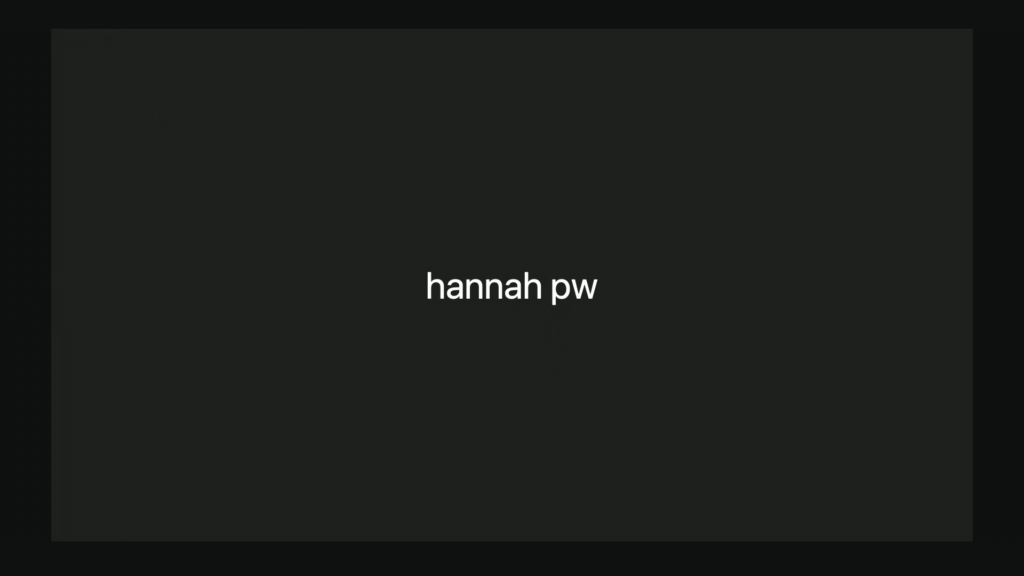
…while I take us… And imagine that you’re getting…you’re shrinking. You’re becoming really tiny and small. So small that you could maybe go inside of the fibers of the sweater that you’re wearing.
Or, for example the…[begins whispering in ASMR tones]…piece of crochet that I was just working on. Here you can see one of those fibers. The white is polyester. But the dark strands are stainless steel. And the copper here is a copper thread. You can see how the copper’s been flattened and wrapped around fibers. And then they are spun together to make them strong and robust.
So I think what I like, can’t get over is that the textiles allow me to really use my body, my eyes, and my skin and my hands, and my smell to work with these materials. It’s happening on a level that I can interact with fully.
And now if you close your eyes again.
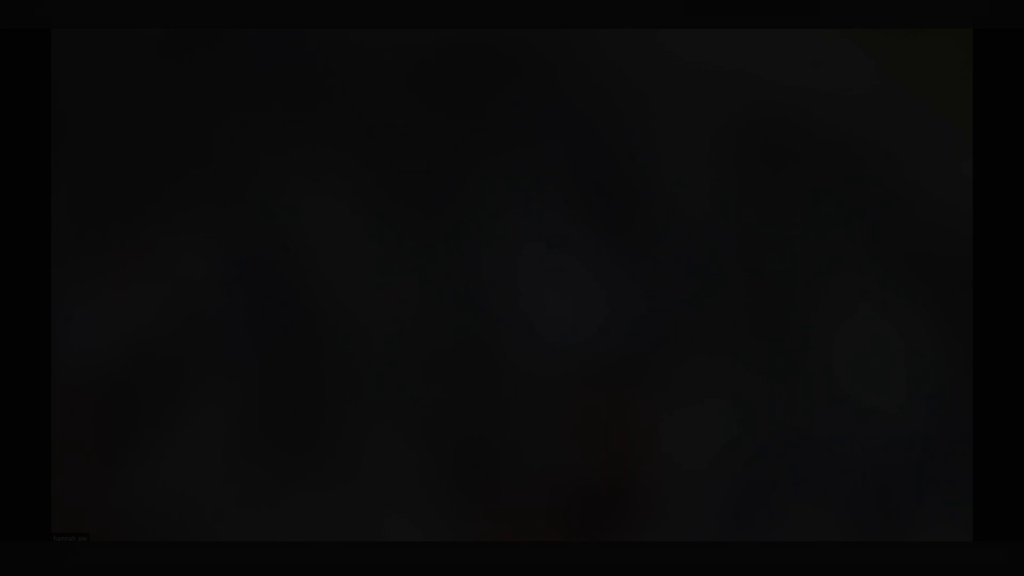
[back to regular speaking voice] So yeah, the early years with e‑textiles were amazing.
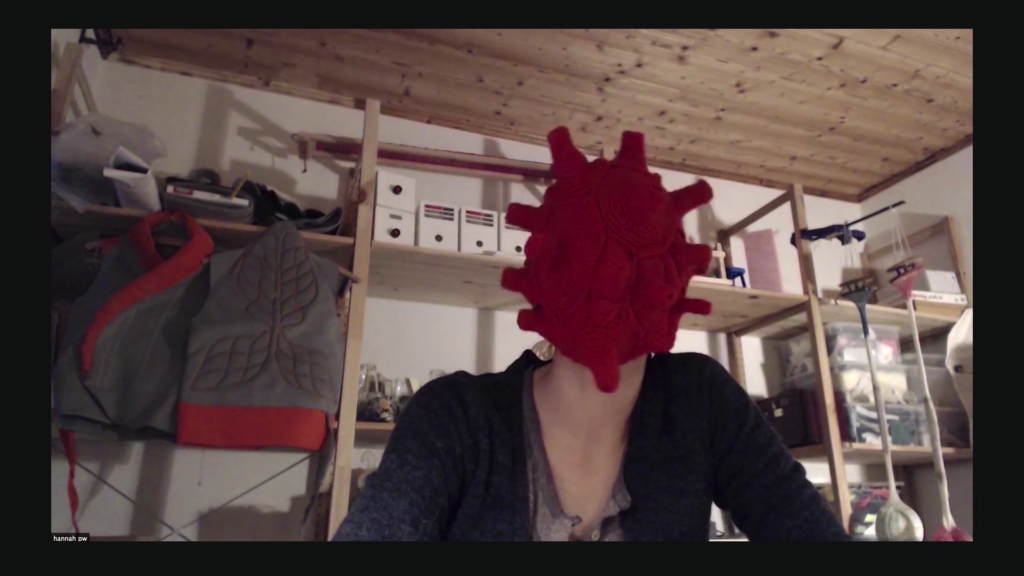
And it was great. Then I’d say about five years ago, I think it was in 2015 when Google actually released a video about its project Jacquard. And it’s a great video because it did a really great job of explaining in beautiful imagery what electronic textiles are. How they’re made. What you could do with them. And they collaborated with a lot of designers—or…not sure how many but they collaborated with designers and companies because they then were looking to try to prototype and implement e‑textiles into things that could become the next line of products in the market.
And seeing this video—and it shouldn’t have been a surprise to me or to other people I think who had been working in e‑textiles from this more crafty end. But somehow it was. It was this kind of shock that this kind of fantastical world of technology that we had been imagining all kinds of fun interactions and projects with was all of a sudden so close to the market. And this idea of the things that we were doing were no longer separatable from what was going on in the realm of technology that we weren’t necessarily so happy about.
I think we were also really surprised to see that in an age where we knew about issues of e‑waste, and kind of fast fashion, and textile industry pollution, that the product ideas that were coming out of— It wasn’t just Google, there were lots of companies at the time bringing out ideas. But there was very little thoughtfulness about what’s going to happen with these products in the kind of greater lifecycle of their contribution.
So yeah, that’s really kind of…that was a moment in time where things went a bit downhill and they’ve not really recovered since then. A lot of the work that I showed from the early years wasn’t just done by me alone. Since I met e‑textiles I’ve been collaborating with Mika Satomi under the collective KOBAKANT. And we both had this kind of experience. And I remember we then went to a cafe one day to talk about like what kinds of things do we want to work on now that this kind of in-love period was kind of coming to an end.
And it didn’t take us long to come up with this idea that we wanted to do something that would allow us to discuss these issues with other people. And we had this idea to open an e‑textile tailor shop as a place opposed to this idea of mass-producing e‑textile products to custom-making e‑textiles for individual people. And in order to find out what would people want if a place like this existed, we thought we’d just need to open it up. And we called it Koba. And I don’t have any pictures of it. So I kind of set up a bit of a reenactment of it.
So this is Koba. We got funding and we saved up our money so that we could rent a space. This was a shopfront space in Berlin, in Kreuzberg. And it was quite a big space. You would kind of enter in, and the first room was kind of the showroom, where there were examples of what you could do with e‑textiles so that people who came in could get a bit of an idea. And in the back we had kind of a couch area where we would sit and talk and eat lunch. We had a kitchen in the back where we cooked lunch every day.
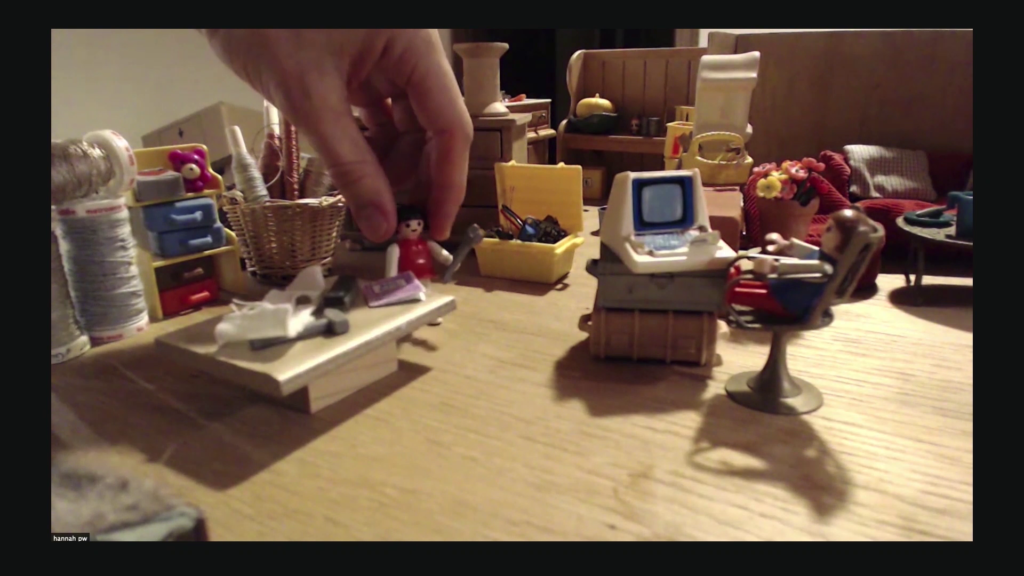
And then the main part of the tailor shop was the actual workshop where the tailoring happened. So on a kind of regular day in the tailor shop this would be hannah. And this is Mika. And I’d have been sitting at the computer doing some custom PCB layouting, or the taxes. And Mika had this beautiful big work table where we did everything from pattern-making to circuit layout and also constructing things.
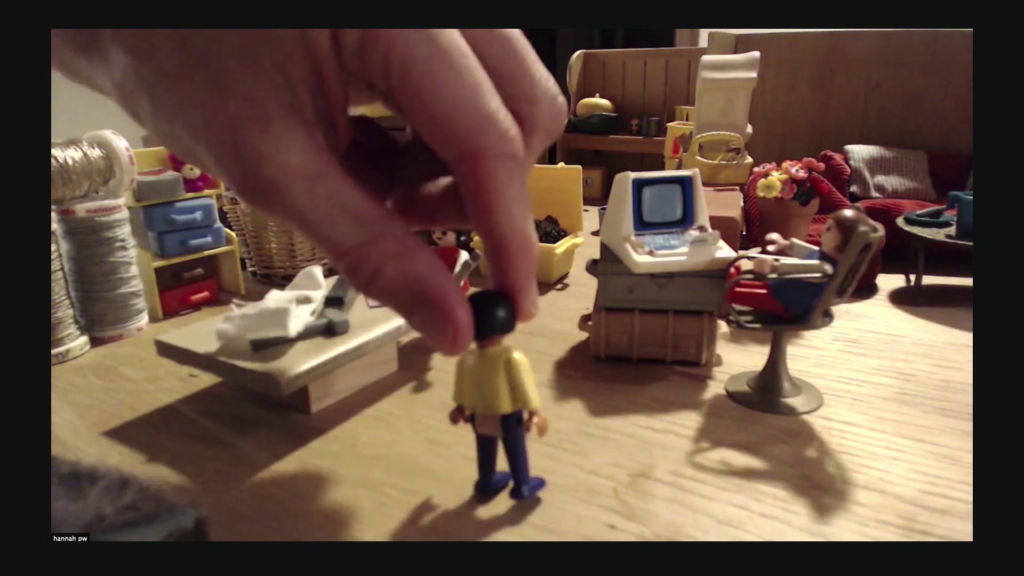
So we would be working on a project and… Not that it happened so often, but every once in a while somebody would actually walk in to the tailor shop and they would come in with an idea of something that they wanted. And this was Boris. He’s actually a humanities professor, but he also plays in a street music band. And he wanted to have a light-up jacket for his band. He plays the trombone. And he wanted it to light up as he was playing his instrument. So he came in, and whenever a new customer came in we would spend some time talking about the idea how and we could possibly implement it. And we would draw sketches, and we would then work on making up a toile, like a prototype of the garment to figure out the fit. We would also prototype the circuit separately, and make tests for the sensing and the actuating.
And then Boris would have gone away. And normally it would take us two or three weeks, sometimes even longer for the two of us, and sometimes we would even get outside help, and a lot of late nights to then finish the orders for the customers. And so then Boris would have come back and received his…we called it the Trombone Breathing Vest, was the commission that he received. And I don’t have any pictures here, but if you go online to the Koba tailor shop web site, if you go to the Trombone Breathing Vest commission, you can see pictures of the vest and watch a video of him playing his trombone with it lighting up.
And so Koba was basically kind of like a fairy tale. And to keep the relationship analogy, maybe it was something like a romantic holiday, where for one year we made believe that we were e‑textile tailors and that this was a life that we could live.
But it wasn’t financially sustainable, and it was never intended to be. And Koba, we closed the shop two years ago now. And since then we’ve kind of been recovering a bit financially and…maybe also mentally. And I think some of the best advice I got since then has actually come from Daniela Rosner, who’s speaking tomorrow I think. And yeah, it’s kind of along the lines of it’s not about breaking up and running away from technology or e‑textiles just because I’m upset with some of the things that I see. But rather if I want to be happy in the long run it’s about cultivating a kind of—or caring about something. So caring about e‑textiles. And if I care about it enough, I could use that to bring up the energy to look to see where it’s broken and to work towards fixing it.
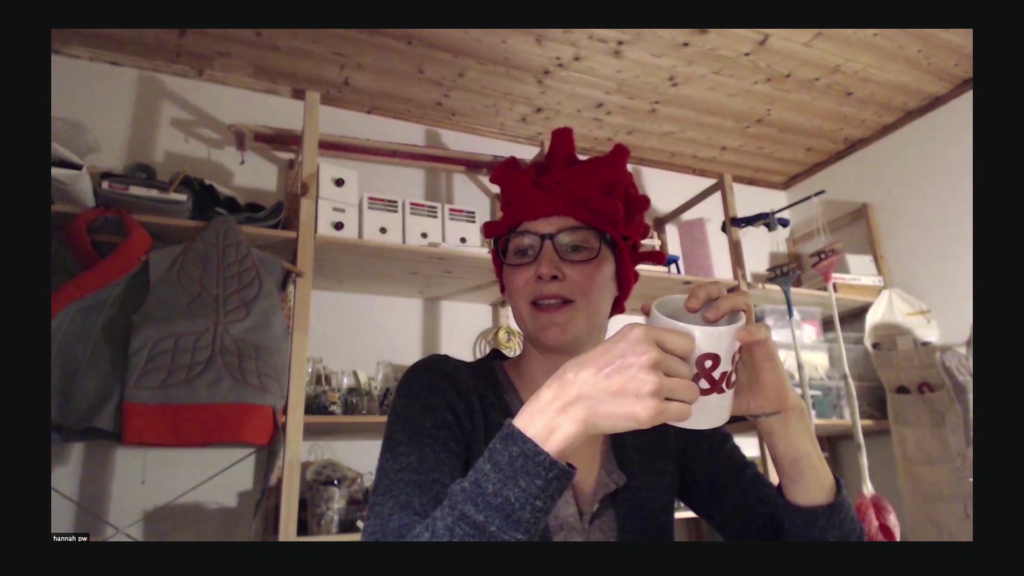
So I think I’m at the point now where I’m no longer thinking of breaking up and running away from e‑textiles, but I’m definitely also still working through the issues that that I see with this field.
And yeah, so last year I departed on a new e‑textile adventure, as Golan mentioned. I’m now a professor at the performing arts university in Berlin. And our masters program is called Spiel und Objekt, or “Play and Object.” And I think I’m kind of taking e‑textiles with me into this new position because I’m thinking I have a chance to enjoy working with it as I see e‑textiles as kind of a prop for storytelling, and for trying out other ways of being in the world.
And it’s also kind of coming full circle. I’m back in an education setting again, which for me is a place of exploration but also research. And not to be doing that alone. So I think what I told you that what seduced me about e‑textiles was the kind of craftiness, and that I could use my hands, and the materials are so… Yeah, to me they’re beautiful and aesthetically really interesting. But I think that was a bit of a trick. That was kind of the shiny, sexy surface. But I think what really sustained my practice over the last years was that I was also part of a community of people practicing in this field. And so I see being part of this educational program as also an opportunity for more community-building and exploring technology together.
I still have some time left. And I don’t know, I recently was reading a kind of an advice book on how to choose a partner. So maybe I can read a passage from… This is something I was reading when I was not quite sure I was going to stay working in e‑textiles.
When you make a choice, you change the future. Choosing a romantic partner is one of contemporary life’s biggest adventures. Embark on a quest and we may meet fascinating people, as well as some who make us crazy. We may rise to emotional heights, as well as sinking into fury, fear, and depression. We may lose direction completely before at last we find our way to love. The real challenge is that we grow. Partner choice is a self-development journey, driving us to learn more about ourselves, about other people, about life and the way we want to live it. Take all that on board, and we start to realize just how big an adventure choosing a partner is.
So…yeah, thank you for indulging me on my relationship issues. I guess there’s time for questions now, but also I would really love if you have…I don’t know if it’s advice or just also if you could share from your own experiences with your work relationship how you manage to sustain it through difficult times and keep yourself excited about what you do. Thank you.
Golan Levin: hannah, thank you so much for this incredible view into your practice and your passion. It’s really easy to understand how fifteen years of relationship with a technologized creative medium could really evolve a lot, you know, since 2005 let’s say. Where you have the maker movement and this kind of bright, shiny kind of thing that that was, and sort of the ride that we’ve been on as we’ve kind of come out of that is really interesting. And it’s super interesting for us to hear about your relationship to this, especially as things that start small and kind of punk become kind of adopted by Google and take certain things maybe away from us, or we think might.
It’s really interesting to see your view. There’s a question from the Discord which is, do you see yourself primarily as a storyteller, with these materials as your medium? And is that your true love now, perhaps?
hannah perner-wilson: Wow, that’s… I think yeah, it’s exactly what I’ve been trying to remind myself. That’s why I took on this professorship job in this performing arts university, because I wanted to give myself a push in the storytelling direction. So I don’t know if I see myself as it yet but yeah. That’s where I’d like to go.
Levin: You’re in a program in Berlin that’s one of the few programs in the world that has a program in digital puppetry as well, which is a super interesting sort of parallel connection as well.
It seems— I mean, you’re fantastically creative. I spent an afternoon going through your Flickr site looking for images and was just overwhelmed with the efflorescence of you creativity. You must hold a lot of projects in your heart, though. I mean, things that you’ve made that are special to you or that you felt good about because they touched someone. Do you have another story to tell about a project you made, maybe at the tailor shop or a thing you made that was never intended to be mass-produced but just a thing that you feel close to that you can leave us with? Or a story.
perner-wilson: Yeah…I’m scouring the room now to find something that…
Levin: Or an experience of a gift, perhaps, that you received or gave that…or some story.
perner-wilson: You know what, that is kind of easy because I have here—
Two Christmases ago, I decided to write a story for my parents. Because for a while I’ve been sick of Christmas gifts and I thought… I wanted my parents to dress up and be silly with me. So I wrote them this story and then I made masks for the characters in the story. And then I made them put on these masks and then we went over to the neighbors and scared them with this.
But in the story…it was kind of set in the future, and the beings in the future…different kind of beings had evolved, but one of these beings was homo lumens. And it had managed to form some kind of synergy with…there’s moths here and some pine cones…in order to survive in an atmosphere on Earth where the sun has disappeared. And in order to form this synergy which allowed the humans to draw oxygen from the environment, but every time they would breath in it required so much energy that they couldn’t think. So their thinking was very well-organized but kind of compartmentalized. So this mask actually connected to kind of a breathing sensor. And every time you breathed in it would light up…this crocheted part here would glow, because it was requiring so much energy to breathe. And I had this image in my head of us all sitting around in the living room in the dark, and only the breathing of our masks would be illuminating the space.
Levin: hannah, there’s so much permission that you’ve given us as a gift in this presentation today. I mentioned yesterday to Irene the permission to be a hybrid. But you’ve given us so many other kinds of permission in this presentation. I just wanted to say thank you so much. I don’t even want to put names to them all. There’s a lot to think about, some of which is verbal and some of which is not. It’s great to get this view onto your creative practice.
perner-wilson: Thank you so much, Golan, for the opportunity to present.
Levin: It’s great. So, that concludes our morning session. We will gather again today at 1:30 in the afternoon Eastern time, with Ari Melenciano for our afternoon session. And I’ll see you all there. Thanks everyone, and have a good lunch.
perner-wilson: Bye bye.
Levin: Bye.
